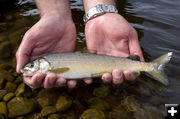

Electrofishing
Pinedale fish crew for the Wyoming Game and Fish Department sample a stretch of the Green River using electrofishing in 2008. Photo by Mark Gocke, Wyoming Game & Fish.
|


Whitefish
A mountain whitefish is released back into the Green River after being captured by Pinedale fish managers using electrofishing in 2008. Photo by Mark Gocke, Wyoming Game & Fish.
|


Electrofishing
Pinedale fish crew for the Wyoming Game and Fish Department sample a stretch of the Green River using electrofishing in 2008. Photo by Mark Gocke, Wyoming Game & Fish.
|
|
Electrofishing expanded on Green River
by Wyoming Game and Fish Department
November 13, 2009
Fish biologists with the Wyoming Game and Fish Department in Pinedale recently completed this yearís fish sampling on the Green River, obtaining important information on fish population trends for more than 130 stream miles from Green River lakes to Fontenelle Reservoir.
Historically, fish biologists have sampled different sections of the popular fishery annually between Green River Lakes and LaBarge to get a picture of the fish population and compare it to data from previous years. This year, however, biologists were able to collect data on two new sections, adding to an extensive data set that goes back to the early 1950ís.
"Several sections of the river have been studied for years," says Darren Rhea, Pinedale Fisheries Biologist with the Wyoming Game and Fish Department. "However, other sections have received relatively little attention." Of particular interest this year were the extreme upper section below Green River Lake and the lower section just above Fontenelle Reservoir. Both reaches are annually stocked with trout and attract large numbers of anglers, but information on these fish populations has been lacking.
This yearís survey work conducted near the town of LaBarge yielded a population estimate of roughly 150 trout per mile. Of the fish captured, nearly one-third were adult cutthroat trout, likely the result of Wyoming Game and Fish Department stocking efforts in the river. "I was excited to see a relatively large number of adult cutthroat," says Rhea, "indicating that our stocking efforts are contributing to diversity and increased opportunities across several miles of the river."
The section below Green River Lake yielded slightly fewer fish, but indicated a greater contribution of wild reproduced fish than previously thought. "Our management practices for this section of the river historically relied on a large numbers of hatchery fish," says Rhea. "Thanks to our sampling efforts, we will be better able to adjust our stocking rate to conform with natural reproduction and angling pressure."
Electrofishing is a common scientific survey method used by fish biologists throughout the country for years, and requires USFWS certification to be used in Wyoming. Boats equipped with generators and electrodes that dip into the water, slowly float downstream, producing an electrical current that temporarily immobilizes the fish, causing them to float to the surface. This allows fish biologists to catch them with a dip-net and drop them into a live well on the boat. Within minutes, the fish recover and are back to normal.
"Electrofishing is generally harmless to trout, which are captured and removed from the electric field immediately" says Rhea.
"Unfortunately, some other non-target fish such as white sucker (non-native invasive fish) and occasionally mountain whitefish (native fish) do experience some mortality." Mortality of a few individuals of these species is not uncommon and anglers will occasionally report seeing dead fish along the bottom of the river immediately after electrofishing work has been completed. "Though the mortality of our native whitefish is undesirable, these population estimates are a very important management tool allowing us to monitor fish populations. Additionally, years of evaluation have shown no negative lasting impacts to those native fish populations."
Captured trout are temporarily displaced downstream within holding tanks aboard the biologistís watercraft. Though they may not immediately return to the exact location of their capture, studies have demonstrated that most trout will return to their favorite spot within a matter of a few days, showing strong fidelity for specific locations in the river. "Anglers occasionally will report that fish were not in the same spot or disappeared from the river following the completion of electrofishing," says Rhea. "Actually, the fish are all still there and well. They may just have moved around a little bit and, given enough time, will return".
Rhea encourages interested anglers to stop by the Game and Fish Office or give him a call any time to discuss electrofishing, the information gained in the surveys and their approach to management of the Green River. He also explains that he will often try to make arrangements for people to come observe his electrofishing operation to see firsthand.
For more information on the Green River or other Pinedale area fisheries, you may contact the Pinedale Game and Fish Office at 1-800-452-9107 (in-state only) or 307-367-4353.
Photo by Mark Gocke, Wyoming Game & Fish.
|


